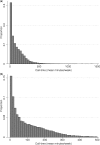Headache, tinnitus and hearing loss in the international Cohort Study of Mobile Phone Use and Health (COSMOS) in Sweden and Finland
- PMID: 31302690
- PMCID: PMC6857740
- DOI: 10.1093/ije/dyz127
Headache, tinnitus and hearing loss in the international Cohort Study of Mobile Phone Use and Health (COSMOS) in Sweden and Finland
Abstract
Background: Mobile phone use and exposure to radiofrequency electromagnetic fields (RF-EMF) from it have been associated with symptoms in some studies, but the studies have shortcomings and their findings are inconsistent. We conducted a prospective cohort study to assess the association between amount of mobile phone use at baseline and frequency of headache, tinnitus or hearing loss at 4-year follow-up.
Methods: The participants had mobile phone subscriptions with major mobile phone network operators in Sweden (n = 21 049) and Finland (n = 3120), gave consent for obtaining their mobile phone call data from operator records at baseline, and filled in both baseline and follow-up questionnaires on symptoms, potential confounders and further characteristics of their mobile phone use.
Results: The participants with the highest decile of recorded call-time (average call-time >276 min per week) at baseline showed a weak, suggestive increased frequency of weekly headaches at 4-year follow-up (adjusted odds ratio 1.13, 95% confidence interval 0.95-1.34). There was no obvious gradient of weekly headache with increasing call-time (P trend 0.06). The association of headache with call-time was stronger for the Universal Mobile Telecommunications System (UMTS) network than older Global System for Mobile Telecommunications (GSM) technology, despite the latter involving higher exposure to RF-EMF. Tinnitus and hearing loss showed no association with call-time.
Conclusions: People using mobile phones most extensively for making or receiving calls at baseline reported weekly headaches slightly more frequently at follow-up than other users, but this finding largely disappeared after adjustment for confounders and was not related to call-time in GSM with higher RF-EMF exposure. Tinnitus and hearing loss were not associated with amount of call-time.
Keywords: Cohort studies; cell phones; headache; hearing loss; tinnitus.
© The Author(s) 2019. Published by Oxford University Press on behalf of the International Epidemiological Association.
Figures
Similar articles
-
Long-term effect of mobile phone use on sleep quality: Results from the cohort study of mobile phone use and health (COSMOS).Environ Int. 2020 Jul;140:105687. doi: 10.1016/j.envint.2020.105687. Epub 2020 Apr 8. Environ Int. 2020. PMID: 32276731 Free PMC article.
-
Cohort study on the effects of everyday life radio frequency electromagnetic field exposure on non-specific symptoms and tinnitus.Environ Int. 2012 Jan;38(1):29-36. doi: 10.1016/j.envint.2011.08.002. Epub 2011 Sep 10. Environ Int. 2012. PMID: 21982030
-
Symptoms and the use of wireless communication devices: A prospective cohort study in Swiss adolescents.Environ Res. 2017 Apr;154:275-283. doi: 10.1016/j.envres.2017.01.004. Epub 2017 Jan 20. Environ Res. 2017. PMID: 28113068
-
The effect of exposure to radiofrequency fields on cancer risk in the general and working population: A systematic review of human observational studies - Part I: Most researched outcomes.Environ Int. 2024 Sep;191:108983. doi: 10.1016/j.envint.2024.108983. Epub 2024 Aug 30. Environ Int. 2024. PMID: 39241333
-
The effect of exposure to radiofrequency fields on cancer risk in the general and working population: A systematic review of human observational studies - Part II: Less researched outcomes.Environ Int. 2025 Feb;196:109274. doi: 10.1016/j.envint.2025.109274. Epub 2025 Jan 11. Environ Int. 2025. PMID: 39904670
Cited by
-
Low Evidence for Tinnitus Risk Factors: A Systematic Review and Meta-analysis.J Assoc Res Otolaryngol. 2023 Feb;24(1):81-94. doi: 10.1007/s10162-022-00874-y. Epub 2022 Nov 15. J Assoc Res Otolaryngol. 2023. PMID: 36380120 Free PMC article.
-
An Experimental Study of Effects of Media Implication on Self-Report Symptoms Related With MP Use.Front Public Health. 2020 May 13;8:175. doi: 10.3389/fpubh.2020.00175. eCollection 2020. Front Public Health. 2020. PMID: 32478030 Free PMC article. Clinical Trial.
-
The effect of exposure to radiofrequency fields on cancer risk in the general and working population: A protocol for a systematic review of human observational studies.Environ Int. 2021 Dec;157:106828. doi: 10.1016/j.envint.2021.106828. Epub 2021 Aug 22. Environ Int. 2021. PMID: 34433115 Free PMC article.
-
Use of Mobile Phones and Radiofrequency-Emitting Devices in the COSMOS-France Cohort.Int J Environ Res Public Health. 2024 Nov 14;21(11):1514. doi: 10.3390/ijerph21111514. Int J Environ Res Public Health. 2024. PMID: 39595781 Free PMC article.
-
The mediating effect of rumination and fear of missing out between mobile phone addiction and sleep quality among college students.Sci Rep. 2024 Nov 9;14(1):27394. doi: 10.1038/s41598-024-79235-z. Sci Rep. 2024. PMID: 39521832 Free PMC article.
References
-
- AGNIR 2012. Advisory Group on Non-Ionising Radiation. Health Effects of Radiofrequency Electromagnetic Fields http://webarchive.nationalarchives.gov.uk/20140629102627/http://www.hpa.org.uk/webw/HPAweb&HPAwebStandard/HPAweb_C/1317133826368
-
- Non-Ionizing Radiation, Part 2. Radiofrequency Electromagnetic Fields. IARC Monograph 102. Lyon: International Agency for Research on Cancer, 2013.
-
- SCENIHR. Scientific Committee on Emerging and Newly Identified Health Risks. Potential Health Effects of Exposure to Electromagnetic Fields. European Commission, 2015. http://ec.europa.eu/health/scientific_committees/emerging/docs/scenihr_o... - PubMed
-
- Oftedal G, Straume A, Johnsson A, Stovner LJ.. Mobile phone headache: a double-blind sham-controlled provocation study. Cephalalgia 2007;27:447–55. - PubMed
Publication types
MeSH terms
Grants and funding
LinkOut - more resources
Full Text Sources
Medical
Miscellaneous



